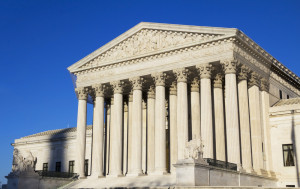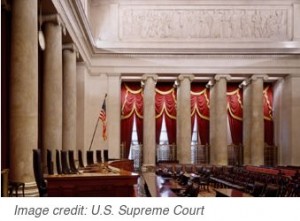 Today, the U.S. Supreme Court handed down its decision in the much-anticipated case Burwell v. Hobby Lobby Stores, Inc. (formerly Sebelius v. Hobby Lobby Stores, Inc., consolidated with Conestoga Wood Specialties Corp. v. Burwell and Autocam Corp. v. Burwell).
Today, the U.S. Supreme Court handed down its decision in the much-anticipated case Burwell v. Hobby Lobby Stores, Inc. (formerly Sebelius v. Hobby Lobby Stores, Inc., consolidated with Conestoga Wood Specialties Corp. v. Burwell and Autocam Corp. v. Burwell).
In a 5-4 opinion by Justice Samuel Alito, the Court held that the Religious Freedom Restoration Act (RFRA) permits a closely held for-profit corporation to deny its employees the health coverage of contraceptives to which the employees are otherwise entitled by the federal Patient Protection and Affordable Care Act of 2010 (ACA), based on the religious objections of the corporation’s owners.
Here is some commentary tracking the progress of these cases before the Court’s ruling:
- Vikram David Amar and Alan Brownstein, Consistency in the Treatment of Religious Liberty Claims: Hobby Lobby and Town of Greece Viewed Side by Side (February 28, 2014)
- Vikram David Amar and Alan Brownstein, The Narrow (and Proper) Way for the Court to Rule in Hobby Lobby’s Favor (April 11, 2014)
- Michael Dorf, Supreme Court Oral Argument Shows How Religious Freedom Claims Have Become Ideologically Charged (March 26, 2014)
- Marci Hamilton, Why the En Banc Tenth Circuit’s Interpretation of the Religious Freedom Restoration Act in Hobby Lobby v. Sebelius Is Indefensible (July 11, 2013)
- Marci Hamilton, The Insatiable Demand for Extreme Religious Liberty Under the RFRAs, Part I: Why Hobby Lobby Falls Outside RFRA’s Protections (March 6, 2014)
- Marci Hamilton, The Lessons of the New Mississippi RFRA that Shed Light on the Hobby Lobby and Conestoga Wood Cases Pending at the Supreme Court (May 15, 2014)
- Marci Hamilton, What RFRA Has Wrought: Hobby Lobby, Onionhead, and the Perils of Religious Triumphalism (June 16, 2014)
Below are the relevant dockets and opinions in the lower courts:
Hobby Lobby
- U.S. District Court for the Western District of Oklahoma
- Docket: Hobby Lobby Stores Inc. v. Sebelius
- Opinion: Hobby Lobby Stores Inc. v. Sebelius (November 19, 2012)
- U.S. Court of Appeals for the Tenth Circuit
- Docket: Hobby Lobby Stores Inc. v. Sebelius
- Opinion: Hobby Lobby Stores Inc. v. Sebelius (June 27, 2013)
Conestoga Wood
- U.S. District Court for the Eastern District of Pennsylvania
- Docket: Conestoga Wood Specialties Corp. v. Sebelius
- Opinion: Conestoga Wood Specialties Corp. v. Sebelius (January 11, 2013)
- U.S. Court of Appeals for the Third Circuit
Here are some resources for the consolidated cases before the U.S. Supreme Court:
- Oral Argument and Transcript (via SupremeCourt.gov)
- Merit and Amicus Briefs Filed (via American Bar Association)
- Opinion: Burwell v. Hobby Lobby Stores, Inc.

 By now, you’ve all read that Justice Antonin Scalia made a series of mistakes in the dissenting opinion of EPA v. EME Homer City Generation, L.P. The Supreme Court issued a corrected version of the opinion on its website. For more on the story, read the coverage in the
By now, you’ve all read that Justice Antonin Scalia made a series of mistakes in the dissenting opinion of EPA v. EME Homer City Generation, L.P. The Supreme Court issued a corrected version of the opinion on its website. For more on the story, read the coverage in the 